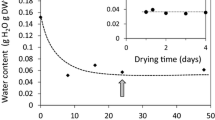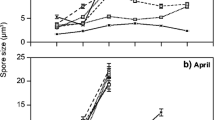Abstract
The effects of age of ascospores (0–18 days after discharge), photon flux density (0–494 μmol m−2 s−1 PAR), temperature (4–30 °C), frost (−15 °C for 30 min), relative humidity (RH; 0–100%), pH (2.5–6.5) and dryness (0 and 53% RH for up to 40 min) on the germination of the ascospores of the mycotoxin-producing fungus Gibberella zeae (anamorph Fusarium graminearum) were studied. Freshly discharged ascospores germinated within 4 h at 20 °C and 100% RH. The rate of germination and the percentage of viable ascospores decreased over time after the spores were discharged from perithecia. The time course of ascospore germination was not significantly affected by photon flux density. The period of time required to obtain 50% germinated ascospores at 100% RH was 26.90 h at 4 °C, 10.40 h at 14 °C, 3.44 h at 20 °C and 3.31 h at 30 °C. There was no significant effect of frost on the percentage of viable ascospores. A small percentage (6.6 ± 3.8%) of the ascospores germinated at 53% RH. At RH ≥ 84% and 20 °C almost 100% of the freshly discharged ascospores germinated. The time course of ascospore germination was affected by pH. The maximum rate of ascospore germination was estimated to be at pH 3.76. Ascospores lost their ability to germinate following exposure to 0% RH almost instantaneously. No germinating spores were detected after an incubation period of 1 min at 0% RH. Incubating the ascospores at 53% RH decreased the percentage of viable spores from 93 to 6% within 10 min. The data demonstrate that age of spores, relative humidity, temperature and pH, but not photon flux density, are key factors in germination of G. zeae ascospores.
Similar content being viewed by others
References
G Ayerst (1969) ArticleTitleThe effect of moisture and temperature on growth and spore germination in some fungi Journal of Stored Products Research 5 127–141
G-H Bai G Shaner H Ohm (2000) ArticleTitleInheritance of resistance to Fusarium graminearum in wheat Theoretical and Applied Genetics 100 1–8
M Beyer S Röding A Ludewig J-A Verreet (2004) ArticleTitleGermination and survival of Fusarium graminearum macroconidia as affected by environmental factors Journal of Phytopathology 152 92–97
A Bottalico G Perrone (2002) ArticleTitleToxogenic Fusarium species and mycotoxins associated with head blight in small-grain cereals in Europe European Journal of Plant Pathology 108 611–624 Occurrence Handle10.1023/A:1020635214971 Occurrence Handle1:CAS:528:DC%2BD38XnvVyisL0%3D
Brown DW, Desjardins AE, Yun S-H, Plattner R, Lee T, Dyer R and Turgeon BG (2001) Are Gibberella zeae sexual spores the critical inoculum leading to FHB epidemics? Proceedings of the National Fusarium Head Blight Forum, December 8–10, 2001, Erlanger, KY, USA, p. 104.
CA Clausen F Green (1996) ArticleTitleCharacterization of polygalacturonase from the brown-rot fungus Postia placenta Applied Microbiology and Biotechnology 45 750–754 Occurrence Handle1:CAS:528:DyaK28XkvVynuro%3D
WGD Fernando JD Miller WL Seaman K Seifert TC Paulitz (2000) ArticleTitleDaily and seasonal dynamics of airborne spores of Fusarium graminearum and other Fusarium species sampled over wheat plots Canadian Journal of Botany 78 497–505
WGD Fernando TC Paulitz WL Seaman P Dutilleul JD Miller (1997) ArticleTitleHead blight gradients caused by Gibberella zeae from area sources of inoculum in wheat field plots Phytopathology 87 414–421
J Gilbert D Abramson BD McCallum R Clear (2001) ArticleTitleComparison of Canadian Fusarium graminearum isolates for aggressiveness, vegetative compatibility, and production of ergosterol and mycotoxins Mycopathologia 153 209–215
S Inch WGD Fernando J Gilbert A Tekauz (2000) ArticleTitleTemporal aspects of ascospore and macroconidia release by Gibberella zeae and Fusarium graminearum Canadian Journal of Plant Pathology 22 186
Y Jin X Zhang L Osborne (2001) ArticleTitleSurvival of Gibberella zeae ascospores on the plant surface Phytopathology 91 S44
CJR Klittich JF Leslie (1988) ArticleTitleNitrate reduction mutants in Fusarium moniliforme (Gibberella fujikuroi) Genetics 118 417–423 Occurrence Handle1:CAS:528:DyaL1cXhvVenu7s%3D
A Ludewig (2003) Zur Bedeutung des Mykotoxins Deoxynivalenol im Wirt/Parasit - System Weizen / Fusarium graminearum University of Kiel Germany
SG Markell LJ Francl (2003) ArticleTitleFusarium head blight inoculum: species prevalence and Gibberella zeae spore type Plant Disease 87 814–820
M McMullen R Jones D Gallenberg (1997) ArticleTitleScab of wheat and barley: A re-emerging disease of devastating impact Plant Disease 81 1340–1348
Á Mesterházy (2002) ArticleTitleRole of deoxynivalenol in aggressiveness of Fusarium graminearum and F. culmorum and in resistance to Fusarium head blight European Journal of Plant Pathology 108 675–684 Occurrence Handle10.1023/A:1020631114063 Occurrence Handle1:CAS:528:DC%2BD38XnvVyisL8%3D
Miedaner T, Schilling AG and Geiger HH (2001). Molecular genetic diversity and variation for aggressiveness in populations of Fusarium graminearum and Fusarium culmorum sampled from wheat fields in different countries. Journal of Phytopathology: 641–648.
PE Nelson TA Toussoun FO Marasas (1983) Fusarium Species: An Illustrated Manual for Identification University Park, Pennsylvania State University Press USA
HI Nirenberg (1976) ArticleTitleUntersuchungen über die morphologische und biologische Differenzierung in der Fusarium-Sektion Liseaola Mitteilungen aus der Biologischen Bundesanstalt für Land- und Forstwirtschaft Berlin-Dahlem 127 1–93
T Paulitz (1996) ArticleTitleDiurnal release of ascospores by Gibberella zeae in inoculated wheat plots Plant Disease 80 674–678
Paulitz T (1999). Epidemiology of Fusarium head blight in eastern Canada – When and where. Proceedings of the Canadian Workshop on Fusarium Head Blight: 43–44
M Schollenberger HT Jara S Sucy W Drochner HM Müller (2002) ArticleTitleFusarium toxins in wheat flour collected in an area in southwest Germany International Journal of Food Microbiology 72 85–89 Occurrence Handle1:CAS:528:DC%2BD38XktFSltA%3D%3D Occurrence Handle11843417
K Schulze J Schönherr (2003) ArticleTitleCalcium hydroxide, potassium carbonate and alkyl polyglycosides prevent spore germination and kill germ tubes of apple scab (Venturia inaequalis) Zeitschrift für Pflanzenkrankheiten und Pflanzenschutz 110 36–45 Occurrence Handle1:CAS:528:DC%2BD3sXltVKgt7w%3D
KK Sinha D Bhatnagar (1998) Mycotoxins in Agriculture and Food Safety Marcel Dekker New York, USA
AS Sussman HA Douthit (1973) ArticleTitleDormancy in microbial spores Annual Review of Plant Physiology 24 311–352 Occurrence Handle1:CAS:528:DyaE3sXltVagu7Y%3D
JC Sutton (1982) ArticleTitleEpidemiology of wheat head blight and maize ear rot caused by Fusarium graminearum Canadian Journal of Plant Pathology 4 195–209
JM Sung RJ Cook (1981) ArticleTitleEffect of water potential on reproduction and spore germination by Fusarium roseum ‘graminearum’, ‘culmorum’ and ‘avenaceum’ Phytopathology 71 499–504
F Trail R Common (2000) ArticleTitlePerithecial development by Gibberella zeae: A light microscopy study Mycologia 92 130–138
F Trail H Xu R Loranger D Gadoury (2002) ArticleTitlePhysiological and environmental aspects of ascospore discharge in Gibberella zeae (anamorph Fusarium graminearum) Mycologia 94 181–189
AT Tschanz RK Horst PE Nelson (1976) ArticleTitleThe effect of environment on sexual reproduction of Gibberella zeae Mycologia 68 327–340
A Wexler (1995) Constant humidity solutions DR Lide (Eds) Handbook of Chemistry and Physics. CRC Press Boca Raton, USA 15–23
KA Zeller RL Bowden JF Leslie (2004) ArticleTitlePopulation differentiation and recombination in wheat scab populations of Gibberella zeae from the United States Molecular Ecology 13 563–571 Occurrence Handle14871361
Author information
Authors and Affiliations
Corresponding author
Rights and permissions
About this article
Cite this article
Beyer, M., Verreet, JA. Germination of Gibberella zeae ascospores as affected by age of spores after discharge and environmental factors. Eur J Plant Pathol 111, 381–389 (2005). https://doi.org/10.1007/s10658-004-6470-9
Accepted:
Issue Date:
DOI: https://doi.org/10.1007/s10658-004-6470-9




